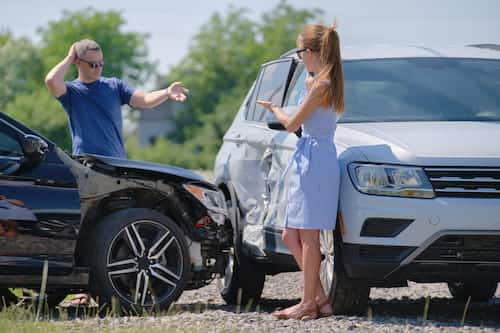
Uninsured/underinsured motorist coverage pays for injuries or property damage caused by a driver who either has no insurance or doesn't have enough insurance to cover the damages. It's required by law in some states.
Last updated: May 14, 2024 Compare quotes in less than 5 minutes
Written by Mark Vallet
Contributing ResearcherMark is a freelance journalist and analyst with over 15 years of experience covering the insurance industry.

Data checked by Brent Buell
Before joining QuinStreet, Brent worked for nearly four years at NYCM Insurance (a personal and commercial insurance carrier based in New York) between his roles as a product analyst and a commercial lines underwriter. Before joining NYCM, Brent owned and operated a captive insurance agency. He holds a property & casualty broker's license and is a Chartered Property Casualty Underwriter (CPCU).

Reviewed by Leslie Kasperowicz
Leslie Kasperowicz is an insurance expert with four years of direct agency experience and over a decade of creating educational content to help insurance shoppers make confident, informed decisions.
Fact checkedAt Insurance.com, we are committed to providing the timely, accurate and expert information consumers need to make smart insurance decisions. All our content is written and reviewed by industry professionals and insurance experts. Our team carefully vets our rate data to ensure we only provide reliable and up-to-date insurance pricing. We follow the highest editorial standards. Our content is based solely on objective research and data gathering. We maintain strict editorial independence to ensure unbiased coverage of the insurance industry.
Uninsured/underinsured motorist (UM/UIM) coverage pays for injuries and property damage if you're involved in an accident with another motorist who is uninsured or doesn't have enough insurance to cover the bills.
Uninsured motorist coverage is required by law in some states, but in others, it's optional. However, insurance experts highly recommend buying UM/UIM.
"Let's say you're driving to the store today, and some 19-year-old [without insurance] plows into the side of your car," says Dave Emmette, chief operating officer and risk advisor at River Valley Insurance in Lowell, Michigan. "That's the type of scenario that plays out across the country every day, and in many cases, those who are hit by an uninsured driver may find they are stuck with expensive medical bills and other costs."
When a driver without insurance is at fault in an accident, they are technically responsible for injuries and damages. Unfortunately, many people who drive without insurance don't have the financial resources to pay those bills. Uninsured motorist coverage protects you.
Uninsured/underinsured motorist coverage (UM/UIM) covers the bills when an uninsured or underinsured motorist causes an accident. It's an optional coverage in some states and required in others.
Your insurer may sell underinsured and uninsured motorist coverage separately, or they may be combined as uninsured/underinsured motorists. State law affects how this coverage is sold.
An uninsured person has no car insurance or insurance coverage that doesn't meet state-mandated minimum liability requirements. Uninsured coverage may also come into play if the other driver's insurance company denies their claim or can't pay it. A hit-and-run driver also counts as uninsured regarding bodily injury, though not normally for property damage.
Underinsured drivers may have minimum insurance required by law, but not enough to cover the damage they cause in an accident. For example, California only requires drivers to carry $15,000 per person and $30,000 per incident of bodily injury liability coverage and only $5,000 in property damage liability. A driver carrying these limits meets the legal requirements but won't have enough coverage if they cause a serious accident. A driver with coverage above the legal limits is underinsured if the bills from the accident exceed their coverage limits.
If you are involved in an accident where the at-fault driver lacks adequate liability insurance, your uninsured/underinsured motorist coverage will kick in to cover your expenses.
There are two types of uninsured/underinsured motorist coverage:
The first covers injuries, and the second covers property damage. If you carry both, then you'll have protection for both medical bills resulting from an accident with an uninsured or underinsured driver and the damage they do to your car or property.
Costs vary, but UM/UIM coverage is generally very affordable. It typically costs roughly 5% of your annual auto insurance premium. For example, if an annual auto insurance premium costs $800, adding UM/UIM insurance will run about $40 annually.
The best way to see what UM/UIM insurance will cost you is to compare car insurance quotes from several companies.
The process for a simple underinsured motorist claim may look like this:
This may differ if you're dealing with an injury claim, especially in a no-fault state where your personal injury protection (PIP) will apply first to your medical bills.
If the other driver has no insurance at all, however, you will need to work solely with your own insurance company for an uninsured motorist claim.
If you have been in an accident, even if you think the other party is at fault, you should immediately call your own insurance company. Filing a claim with your insurer for the accident is the first step to using your uninsured or underinsured motorist coverage.
Until the full cost of the damages is known, you won't know if the other driver has enough insurance. However, if they have no insurance, your insurer can take steps right away to process an uninsured motorist claim.
In some states, you are required by law to carry some level of uninsured motorist coverage. In others it's optional.
The rate of uninsured motorists in your state might help you make the choice,

According to the Insurance Research Council (IRC) 12.6%, or one in eight drivers, are uninsured.
Below, you'll see how states rank by the percentage of uninsured motorists, according to the latest data from the IRC.
| Rank | State | Uninsured % |
|---|---|---|
| 1 | Mississippi | 29.4% |
| 2 | Michigan | 25.5% |
| 3 | Tennessee | 23.7% |
| 4 | New Mexico | 21.8% |
| 5 | Washington | 21.7% |
| 6 | Florida | 20.4% |
| 7 | Alabama | 19.5% |
| 8 | Arkansas | 19.3% |
| 9 | District of Columbia | 19.1% |
| 10 | California | 16.6% |
| 11 | Rhode Island | 16.5% |
| 12 | Missouri | 16.4% |
| 13 | Colorado | 16.3% |
| 14 | Alaska | 16.1% |
| 15 | Indiana | 15.8% |
| 16 | Maryland | 14.1% |
| 17 | Kentucky | 13.9% |
| 18 | Oklahoma | 13.4% |
| 19 | Wisconsin | 13.3% |
| 20 | Idaho | 13.2% |
| 21 | Ohio | 13.0% |
| 22 | North Dakota | 13.0% |
| 23 | Georgia | 12.4% |
| 24 | Arizona | 11.8% |
| 25 | Illinois | 11.8% |
| 26 | Louisiana | 11.7% |
| 27 | Iowa | 11.3% |
| 28 | Kansas | 10.9% |
| 29 | South Carolina | 10.9% |
| 30 | Oregon | 10.7% |
| 31 | Virginia | 10.5% |
| 32 | Nevada | 10.4% |
| 33 | Minnesota | 9.9% |
| 34 | Hawaii | 9.3% |
| 35 | Nebraska | 9.3% |
| 36 | West Virginia | 9.2% |
| 37 | Vermont | 8.8% |
| 38 | Montana | 8.5% |
| 39 | Delaware | 8.5% |
| 40 | Texas | 8.3% |
| 41 | South Dakota | 7.4% |
| 42 | North Carolina | 7.4% |
| 43 | Utah | 6.5% |
| 44 | Connecticut | 6.3% |
| 45 | New Hampshire | 6.1% |
| 46 | Pennsylvania | 6.0% |
| 47 | Wyoming | 5.8% |
| 48 | Maine | 4.9% |
| 49 | New York | 4.1% |
| 50 | Massachusetts | 3.5% |
| 51 | New Jersey | 3.1% |
| National average | 12.6% | |
According to the IRC, the following states have the greatest percentages of uninsured drivers:
New Jersey had the smallest percentage of uninsured drivers, with only 3.1% without coverage in 2019 (the latest year with data).
Nationwide, approximately one in eight drivers is uninsured. However, in some states, as many as one in four or one in five cars on the road is driven by someone without coverage.
If you have a run-in with an uninsured motorist, it can leave you paying for your own injuries and damage and going to court to seek compensation. A much easier route is to carry uninsured motorist insurance as part of your car insurance policy and make a claim for your damages.
However, some other coverages might pay for most of the same damages as UM/UIM. Health insurance can pay your medical bills, while collision coverage will pay for damage to your car regardless of fault. However, UM/UIM isn't costly and provides added protection.
The main function of uninsured motorist vehicle coverage is to help cover your medical bills after an accident involving an uninsured driver. If you have excellent health insurance, UM for bodily injury may not be necessary as your medical bills should be covered by your health insurance.
However, if you have a high deductible health plan or high coinsurance amounts, uninsured motorist coverage makes sense. Uninsured and underinsured motorist coverage will cover your out-of-pocket medical expenses, even if the at-fault driver can't afford to pay.
In addition, UM insurance may pay out for pain and suffering as well as lost wages. According to the National Association of Insurance Commissioners, the average claim payment for UM for injuries is $29,825.
If you are carrying collision coverage, your vehicle will be repaired regardless of whether the person who hit you has insurance or not. However, if you are not carrying collision insurance, you will be on your own when it comes to fixing your vehicle after an accident if you are not covered by UM insurance. According to the National Association of Insurance Commissioners, the average claim payment for UMPD is $1,805.
UM and UIM coverage is voluntary in more than half of U.S. states, but some do require it. The following chart lists the states with uninsured drivers' insurance requirements and indicates the type of coverage that is mandated.
State requirements are shown for uninsured motorist, bodily injury (BI), uninsured motorist property damage (UMPD) coverage, and underinsured motorist property damage (UMIPD) coverage, along with required coverage limits.
States with UM and/or UIM requirements